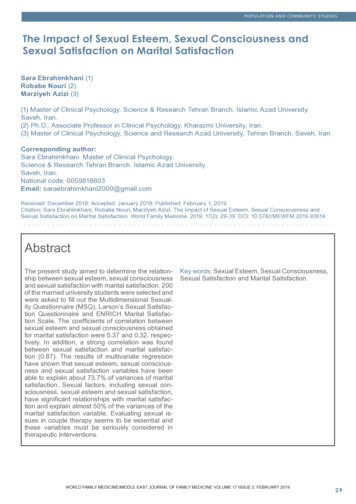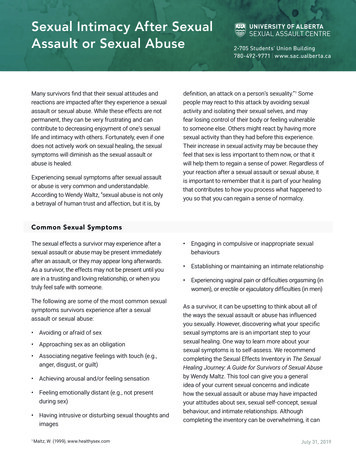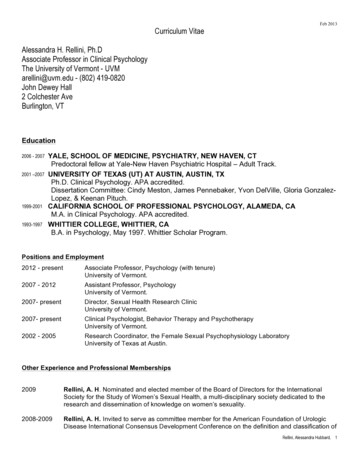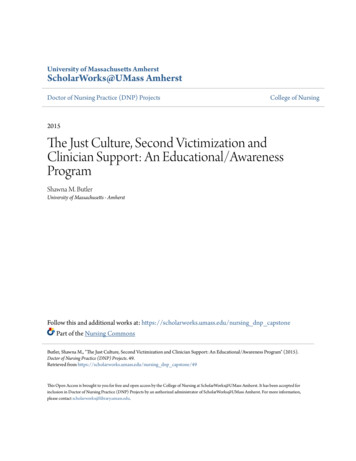
Transcription
U.S. Department of JusticeOffice of Justice ProgramsNational Institute of JusticeResearch ReportThe Sexual Victimizationof College WomenBureau ofJusticeStatisticsBonnie S. FisherFrancis T. CullenMichael G. Turner
U.S. Department of JusticeOffice of Justice Programs810 Seventh Street N.W.Washington, DC 20531Janet RenoAttorney GeneralDaniel MarcusActing Associate Attorney GeneralMary Lou LearyActing Assistant Attorney GeneralJulie E. SamuelsActing Director, National Institute of JusticeOffice of Justice ProgramsWorld Wide Web Sitehttp://www.ojp.usdoj.govNational Institute of JusticeWorld Wide Web Sitehttp://www.ojp.usdoj.gov/nijBureau of Justice StatisticsWorld Wide Web Sitehttp://www.ojp.usdoj.gov/bjs
The Sexual Victimizationof College WomenBonnie S. FisherFrancis T. CullenMichael G. TurnerDecember 2000NCJ 182369
Julie E. SamuelsActing DirectorNational Institute of JusticeJan M. ChaikenDirectorBureau of Justice StatisticsBernard V. AuchterProgram MonitorNational Institute of JusticeMichael R. RandProgram MonitorBureau of Justice StatisticsThe results from the college women studies were supported under award95–WT–NX–0001 from the National Institute of Justice and award97–MU–MU–0011 from the Bureau of Justice Statistics, U.S. Departmentof Justice. Points of view in this document are those of the authors and donot necessarily represent the official position of the U.S. Department ofJustice. Joanne Belknap, Ph.D., worked with Professors Fisher and Cullenon award 95–WT–NX–0001 in developing and revising the surveys and ledthe focus groups with Professor Fisher.The National Institute of Justice and the Bureau of Justice Statistics are components of the Office of Justice Programs, which also includes the Bureau of JusticeAssistance, the Office of Juvenile Justice and Delinquency Prevention, and theOffice for Victims of Crime.
ForewordThis study contributes extremely important data to our understanding aboutthe prevalence and nature of violence against women in the United States.College campuses host large concentrations of young women who are atgreater risk for rape and other forms of sexual assault than women in thegeneral population or in a comparable age group. Based on their findings,Bonnie Fisher and her colleagues estimate that the women at a college thathas 10,000 female students could experience more than 350 rapes a year—a finding with serious policy implications for college administrators.Fisher also found that many women do not characterize their sexual victimizations as a crime for a number of reasons (such as embarrassment, notclearly understanding the legal definition of rape, or not wanting to definesomeone they know who victimized them as a rapist) or because they blamethemselves for their sexual assault. The study reinforces the importance ofmany organizations’ efforts to improve education and knowledge about sexual assault.A unique feature of this study, brought about by joint funding from our twoagencies, is its parallel use of two different survey methods for learningabout sexual assault of women. The differences in estimated levels of sexualassault that are associated with the methodological differences will help usdesign better and more accurate surveys in the future.Julie E. SamuelsActing DirectorNational Institute of JusticeJan M. ChaikenDirectorBureau of Justice Statisticsiii
ContentsForeword . . . . . . . . . . . . . . . . . . . . . . . . . . . . . . . . . . . . . . . . . . . . . . . . . iiiWhat we know about sexual victimization of college women . . . . . . . . . . 2Who was surveyed? . . . . . . . . . . . . . . . . . . . . . . . . . . . . . . . . . . . . . . . . . 3How was sexual victimization measured? . . . . . . . . . . . . . . . . . . . . . . . . . 4What types of sexual victimization were measuredin the NCWSV study? . . . . . . . . . . . . . . . . . . . . . . . . . . . . . . . . . . . . 9How extensive is rape among college women? . . . . . . . . . . . . . . . . . . . . 10How do the NCWSV rape estimates compare with the rape estimatesbased on the National Crime Victimization Survey? . . . . . . . . . . . . . 11Do women define their victimization as a rape? . . . . . . . . . . . . . . . . . . . 15How extensive are other forms of sexual victimization? . . . . . . . . . . . . . 15How extensive is prior sexual victimization? . . . . . . . . . . . . . . . . . . . . . . 16Do victims know their offenders? . . . . . . . . . . . . . . . . . . . . . . . . . . . . . . 17When does sexual victimization occur? . . . . . . . . . . . . . . . . . . . . . . . . . . 18Where does sexual victimization occur? . . . . . . . . . . . . . . . . . . . . . . . . . 18Are women victimized on or off campus? . . . . . . . . . . . . . . . . . . . . . . . . 19Do sexual victims take protective actions during the incident? . . . . . . . . . 19Are victims hurt in the victimization incidents? . . . . . . . . . . . . . . . . . . . . 22Are some women more at risk of being sexually victimized? . . . . . . . . . . 23Do women report victimization incidents to the police? . . . . . . . . . . . . . .23How extensive is stalking? . . . . . . . . . . . . . . . . . . . . . . . . . . . . . . . . . . . . 23What is the nature of stalking incidents? . . . . . . . . . . . . . . . . . . . . . . . . . 28v
Are some women more at risk of being stalked? . . . . . . . . . . . . . . . . . . . 28What is the extent of visual and verbal sexual victimization? . . . . . . . . . . 30Conclusions . . . . . . . . . . . . . . . . . . . . . . . . . . . . . . . . . . . . . . . . . . . . . . . 30Notes . . . . . . . . . . . . . . . . . . . . . . . . . . . . . . . . . . . . . . . . . . . . . . . . . . . . . 35vi
The Sexual Victimization of College WomenDuring the past decade, concern over the sexual victimization of femalecollege students has escalated. In part, the interest in this problem hasbeen spurred by increasing attention to the victimization of women ingeneral; until the relatively recent past, female victims received very littleattention. However, this is no longer true. Terms such as “date rape” and“domestic violence” have entered the public lexicon and signify theunprecedented, if still insufficient, notice given to women who havebeen victimized.Attention to the sexual victimization of college women, however, also hasbeen prompted by the rising fear that college campuses are not ivory towersbut, instead, have become hot spots for criminal activity. Researchers haveshown that college campuses and their students are not free from the risk ofcriminal victimization.1 It is noteworthy that large concentrations of youngwomen come into contact with young men in a variety of public and privatesettings at various times on college campuses. Previous research suggeststhat these women are at greater risk for rape and other forms of sexualassault than women in the general population or in a comparable age group.2College women might, therefore, be a group whose victimization warrantsspecial attention.Recognizing these risks, the U.S. Congress passed the Student Right-toKnow and Campus Security Act of 1990 (hereafter referred to as the act).This legislation mandates that colleges and universities participating inFederal student aid programs “prepare, publish, and distribute, throughappropriate publications or mailings, to all current students and employees,and to any applicant for enrollment or employment upon request, an annualsecurity report” containing campus security policies and campus crimestatistics for that institution (see 20 U.S.C. 1092(f)(1)).3Congress has maintained an interest in campus crime issues, passing legislation that requires higher educational institutions to address the rights ofvictims of sexual victimization and to collect and publish additional crimestatistics (e.g., murder and nonnegligent manslaughter, arson). For example,Congress amended the act in 1992 to include the Campus Sexual AssaultVictims’ Bill of Rights, which requires colleges and universities (1) todevelop and publish as part of their annual security report their policiesregarding the awareness and prevention of sexual assaults and (2) to affordbasic rights to sexual assault victims.4 The act was amended again in 1998to include additional reporting obligations, extensive campus security-relatedprovisions, and the requirement to keep a daily public crime log; some States1
The Sexual Victimization of College Womenalready required a public log (Public Law 105–244).5 The 1998 amendmentsalso officially changed the name of the act to the Jeanne Clery Disclosure ofCampus Security Policy and Campus Crime Statistics Act. In 1999, the U.S.Department of Justice awarded 8.1 million to 21 colleges and universitiesto combat sexual assault, domestic violence, and stalking.6 In 2000, 20 additional schools were awarded 6.8 million. Two national-level studies arecurrently in the field. The first study examines how institutions of highereducation respond to the report of a sexual assault. The second one is a multisite evaluation of the programs and policies implemented in the abovementioned 41 schools.What we know about sexual victimization ofcollege womenLike government officials, researchers also have given attention to the sexualvictimization of college women and have conducted a number of studies.7Although illuminating, much of the research is generally characterized byone or more of the following limitations: The failure to use a randomly selected, national sample of college women.(Many studies have sampled students at only one college or at a limitednumber of institutions.) The failure to assess the various ways in which women can be victimized.(Most studies have focused on a limited number of types of sexualvictimization.) The failure to use question wording or sufficiently detailed measures thatprevent biases that might cause researchers to underestimate or overestimate the extent of sexual victimization. The failure to collect detailed information on what occurred during thevictimization incident. The failure to explore systematically the factors that place female studentsat risk for sexual victimization. The failure to study whether women have been stalked—a victimizationthat, until recently, had not received systematic research.The National College Women Sexual Victimization (NCWSV) study,described in this report and funded by the National Institute of Justice2
The Sexual Victimization of College Women(NIJ), attempted to build on, and surmount the limitations of, existingresearch on the sexual victimization of college students by: Employing a nationally representative sample of college women. Assessing a range of sexual victimizations, including stalking. Measuring sexual victimization using a two-stage process starting with“behaviorally specific” screen questions that attempted to cue respondentsto recall and report to the interviewer different types of sexual victimization experiences they may have had. Those who reported a victimizationwere then asked a series of questions, called an incident report, to verifywhat type of sexual victimization, if any, had occurred. Acquiring detailed information on each victimization incident, includingthe type of penetration(s) or unwanted sexual contact experienced and themeans of coercion, if any, used by the offender. Examining how the risk of being sexually victimized was affected by avariety of variables, including demographic characteristics, lifestyles,prior victimization, and the characteristics of the college or universityattended.In addition, the research project contained a comparison component designedto assess how rape estimates that use the two-stage process (behaviorallyspecific questions and incident reports) compared with rape estimates drawnfrom a sample of college women who completed a survey based on theNational Crime Victimization Survey (NCVS). The comparison componentwas funded by the Bureau of Justice Statistics (BJS).8The resulting data furnish perhaps the most systematic analysis of the extentand nature of the sexual victimization of college women in the past decade.Who was surveyed?NCWSV study results are based on a telephone survey of a randomly selected, national sample of 4,446 women who were attending a 2- or 4-yearcollege or university during fall 1996. The questions were asked betweenFebruary and May 1997. The sample was limited to schools with at least1,000 students and was stratified by the size of the total student enrollment(1,000–2,499; 2,500–4,999; 5,000–19,999; 20,000 or more) and the school’slocation (urban, suburban, and rural). Schools were randomly chosen usinga probability proportional with the size of the total female enrollment.3
The Sexual Victimization of College WomenStudents were then randomly selected using a sampling frame provided bythe American Student List Company. This company provided the schooladdress and telephone number for each student in the sample.Each sample member was sent a letter describing the study and researchprotocol approximately 2 weeks prior to when a trained female interviewercalled using a computer-aided telephone interviewing system.9 The responserate was 85.6 percent.10The comparison component used the same two-stage methodology as themain study except victimization was measured by using the screen questionsand the incident report employed by NCVS. One purpose of the comparisoncomponent was to conduct a methodological experiment that would provideinsight into the extent to which rape estimates are influenced by surveymethods.How was sexual victimization measured?Measurement of sexual victimization was based on responses to “screenquestions” and on a reference period for the victimization. In addition to thevictimization measures, survey questions and secondary data sources wereused to investigate the factors that potentially placed women at risk of beingsexually victimized.Two-stage measurement design: The screenquestion-incident report methodologyWith important exceptions noted later, sexual victimization was measuredlargely by following the two-stage measurement format of NCVS. NCVSfirst asks a series of screen questions that seek to determine if a respondenthas experienced an act that may possibly be a victimization. If the respondent answers “yes,” then for each of the times that the act was experienced,the respondent is asked by the interviewer to complete an “incident report.”This report contains detailed questions about the nature of the events thatoccurred in the incident. The report is used to classify the type of victimization that took place; that is, responses to questions in the incident report—not the screen questions—are used to categorize whether a victimizationoccurred and, if so, what type.Some researchers have contended that the screen questions as worded inNCVS are not detailed enough to identify all women who have experienced4
The Sexual Victimization of College Womena rape or another type of sexual assault. A respondent may not answer “yes”to a screen question unless it is worded in a way that reflects the experiencethe respondent has had. To rectify this limitation, researchers have arguedthat sexual victimization should be measured with screen questions that areboth numerous and detailed enough that respondents will not misunderstandwhat is being asked.11NCWSV, therefore, used a series of behaviorally specific screen questionsthat sought to assess whether respondents had experienced a range of sexualvictimizations. A behaviorally specific question, for example, is one thatdoes not ask simply if a respondent “had been raped”; rather, it describes anincident in graphic language that covers the elements of a criminal offense(e.g., someone “made you have sexual intercourse by using force or threatening to harm you . . . by intercourse I mean putting a penis in your vagina”).The same logic can be used to ask about other forms of sexual victimization, such as sexual coercion or unwanted sexual contact.Examples of the screen questions used in the NCWSV study are listed inexhibit 1. Each completed rape screen question asks the respondent about adifferent form of penetration in which force or the threat of harm was used.A statement then follows each question that defines the type of penetration.For example, anal sex is defined as “putting a penis in your anus or rectum.”The other screen questions provide examples of the behaviors that respondents were asked about.The NCWSV rape screen questions are similar, if not identical, to thoseused by Kilpatrick and his associates12 and by Tjaden and Thoennes.13 Theuse of behaviorally specific screen questions is an important differencebetween the current survey and NCVS. The NCVS screen questions beginwith a reference to a type of criminal victimization that may have beenexperienced (e.g., “were you attacked or threatened”), which is then followed by a list of short cue responses about the potential victimization.This list includes cues regarding specific places or situations in which thevictimization could have occurred (e.g., “at work or at school”); objectsthat could have been used (e.g., “with any weapon, for instance, a gun orknife”); actions that could have been associated with the victimization(e.g., “face-to-face threats”); actions that constitute a criminal victimization(e.g., “rape, attempted rape, or other types of sexual attack”); and peoplewho might have perpetrated the criminal act (e.g., “a relative or familymember”). There is also a screen question that asks about “incidentsinvolving forced or unwanted sexual acts.”145
The Sexual Victimization of College WomenExhibit 1: Survey Screen QuestionsWomen may experience a wide range of unwanted sexual experiences in college. Womendo not always report unwanted sexual experiences to the police or discuss them with familyand friends. The person making the advances is not always a stranger, but can be a friend,boyfriend, fellow student, professor, teaching assistant, supervisor, coworker, somebody youmeet off campus, or even a family member. The experience could occur anywhere: on or offcampus, in your residence, in your place of employment, or in a public place. You could beawake, or you could be asleep, unconscious, drunk, or otherwise incapacitated. Please keepthis in mind as you answer the questions.Now, I’m going to ask you about different types of unwanted sexual experiences you mayhave experienced since school began in fall 1996. Because of the nature of unwanted sexual experiences, the language may seem graphic to you. However, this is the only way toassess accurately whether or not the women in this study have had such experiences. Youonly have to answer “yes” or “no.” Since school began in fall 1996, has anyone made you have sexual intercourse by usingforce or threatening to harm you or someone close to you? Just so there is no mistake,by intercourse I mean putting a penis in your vagina. Since school began in fall 1996, has anyone made you have oral sex by force or threat ofharm? By oral sex, I mean someone’s mouth or tongue making contact with your vaginaor anus or your mouth or tongue making contact with someone else’s genitals or anus. Since school began in fall 1996, has anyone made you have anal sex by force or threat ofharm? By anal sex, I mean putting a penis in your anus or rectum. Since school began in fall 1996, has anyone ever used force or threat of harm to sexuallypenetrate you with a foreign object? By this, I mean for example, placing a bottle or finger in your vagina or anus. Since school began in fall 1996, has anyone attempted but not succeeded in making youtake part in any of the unwanted sexual experiences that I have just asked you about?For example, did anyone threaten or try but not succeed to have vaginal, oral, or anal sexwith you or try unsuccessfully to penetrate your vagina or anus with a foreign object orfinger? Not counting the types of sexual contact already mentioned, have you experienced anyunwanted or uninvited touching of a sexual nature since school began in fall 1996? Thisincludes forced kissing, touching of private parts, grabbing, fondling, and rubbing upagainst you in a sexual way, even if it is over your clothes. Since school began in fall 1996, has anyone attempted but not succeeded in unwantedor uninvited touching of a sexual nature? Since school began in fall 1996, has anyone made or tried to make you have sexual intercourse or sexual contact when you did not want to by making threats of nonphysicalpunishment, such as lowering a grade, being demoted or fired from a job, damagingyour reputation, or being excluded from a group for failure to comply with requests forany type of sexual activity? Since school began in fall 1996, has anyone made or tried to make you have sexual intercourse or sexual contact when you did not want to by making promises of rewards, suchas raising a grade, being hired or promoted, being given a ride or class notes, or gettinghelp with coursework from a fellow student if you complied sexually? Since school began in fall 1996, has anyone made or tried to make you have sexual intercourse or sexual contact when you did not want to by simply being overwhelmed bysomeone’s continual pestering and verbal pressure?6
The Sexual Victimization of College WomenDrawing on the NCVS screen question and incident report methodology,the NCWSV screen questions were followed by a detailed incident reportthat (1) clarified what type of victimization, if any, had occurred and (2) collected information about various aspects of the incident (e.g., victim-offenderrelationship, whether the victimization took place on or off the collegecampus, whether the incident was reported to the police). Responses to thescreen questions were not used to classify the type of victimization reportedby the respondent. Instead, classification was based on the responses in theincident report to questions about (1) the type of penetration experienced(e.g., penile-vaginal, anal, oral); (2) the type of unwanted sexual contactexperienced (e.g., touching, grabbing, or fondling); and (3) the means ofcoercion used by the perpetrators (e.g., force, threat of force). Like Koss etal. and NCVS, the incidents were classified using a hierarchical algorithm;that is, incidents were classified by the most severe type of sexual victimization that occurred within an incident.15 For example, if within an incidentreport the victim answered questions indicating she had experienced a completed rape and attempted sexual coercion, the incident was classified as acompleted rape.Reference periodTo limit potential response bias due to recall or memory decay, the NCWSVsurvey questions used a reference period that had a clear starting date forstudents. Thus, respondents were asked if they had experienced a sexualvictimization “since school began in fall 1996.” The survey was conductedin 1997 between late February and early May. On average, the referenceperiod for the victimization covered almost 7 months (6.91 months).16 Toparticipate in the study, respondents had to be enrolled in a college or university at the start of the 1996 fall semester.Risk factorsIn addition to the victimization measures, the NCWSV survey containedquestions about respondents’ demographic characteristics, lifestyles or routine activities, living arrangements, prior sexual victimizations, and so forth.Secondary data sources were used to measure the characteristics of theschools the respondents attended (e.g., size of enrollment, location, crimerate). These individual- and institution-level variables were used in multivariate analyses that investigated which factors potentially placed women atrisk of being sexually victimized.7
The Sexual Victimization of College WomenExhibit 2: Descriptions of Types of VictimizationsType of victimization8DefinitionCompleted rapeUnwanted completed penetration by force or the threat offorce. Penetration includes: penile-vaginal, mouth on yourgenitals, mouth on someone else’s genitals, penile-anal,digital-vaginal, digital-anal, object-vaginal, and object-anal.Attempted rapeUnwanted attempted penetration by force or the threat offorce. Penetration includes: penile-vaginal, mouth on yourgenitals, mouth on someone else’s genitals, penile-anal,digital-vaginal, digital-anal, object-vaginal, and object-anal.Completed sexualcoercionUnwanted completed penetration with the threat of nonphysical punishment, promise of reward, or pestering/verbalpressure. Penetration includes: penile-vaginal, mouth onyour genitals, mouth on someone else’s genitals, penile-anal,digital-vaginal, digital-anal, object-vaginal, and object-anal.Attempted sexualcoercionUnwanted attempted penetration with the threat of nonphysical punishment, promise of reward, or pestering/verbalpressure. Penetration includes: penile-vaginal, mouth onyour genitals, mouth on someone else’s genitals, penile-anal,digital-vaginal, digital-anal, object-vaginal, and object-anal.Completed sexual contactwith force or threat offorceUnwanted completed sexual contact (not penetration) withforce or the threat of force. Sexual contact includes: touching; grabbing or fondling of breasts, buttocks, or genitals,either under or over your clothes; kissing; licking or sucking;or some other form of unwanted sexual contact.Completed sexual contactwithout forceAny type of unwanted completed sexual contact (not penetration) with the threat of nonphysical punishment, promiseof reward, or pestering/verbal pressure. Sexual contactincludes: touching; grabbing or fondling of breasts, buttocks,or genitals, either under or over your clothes; kissing; lickingor sucking; or some other form of unwanted sexual contact.Attempted sexual contactwith force or threat of forceUnwanted attempted sexual contact (not penetration) withforce or the threat of force. Sexual contact includes: touching; grabbing or fondling of breasts, buttocks, or genitals,either under or over your clothes; kissing; licking or sucking;or some other form of unwanted sexual contact.
The Sexual Victimization of College WomenExhibit 2: Descriptions of Types of Victimizations, continuedType of victimizationDefinitionAttempted sexual contactwithout forceUnwanted attempted sexual contact (not penetration) withthe threat of nonphysical punishment, promise of reward, orpestering/verbal pressure. Sexual contact includes: touching;grabbing or fondling of breasts, buttocks, or genitals, eitherunder or over your clothes; kissing; licking or sucking; orsome other form of unwanted sexual contact.Threat of rapeThreat of unwanted penetration with force and threat offorce. Penetration includes: penile-vaginal, mouth on yourgenitals, mouth on someone else’s genitals, penile-anal, digitalvaginal, digital-anal, object-vaginal, and object-anal.Threat of contact withforce or threat of forceThreat of unwanted sexual contact with force and threat offorce. Sexual contact includes: touching; grabbing orfondling of breasts, buttocks, or genitals, either under orover your clothes; kissing; licking or sucking; or some otherform of unwanted sexual contact.Threat of penetrationwithout forceThreat of unwanted penetration with the threat of nonphysical punishment, promise of reward, or pestering/verbal pressure. Penetration includes: penile-vaginal, mouth on yourgenitals, mouth on someone else’s genitals, penile-anal,digital-vaginal, digital-anal, object-vaginal, and object-anal.Threat of contact withoutforceThreat of unwanted sexual contact with the threat of nonphysical punishment, promise of reward, or pestering/verbalpressure. Sexual contact includes: touching; grabbing orfondling of breasts, buttocks, or genitals, either under orover your clothes; kissing; licking or sucking; or some otherform of unwanted sexual contact.What types of sexual victimization weremeasured in the NCWSV study?Measures of 12 types of sexual victimization were constructed; they aredefined in exhibit 2. Most important, the NCWSV study included measuresof both completed and attempted rape as well as threats of rape. The studyalso measured completed, attempted, and threatened sexual coercion (penetration with the use of nonphysical forms of coercion) and unwanted sexualcontact (sexual contact, but not penetration, with force or threat of force). Inaddition, the study measured stalking and visual and verbal forms of sexualvictimization.9
The Sexual Victimization of College WomenHow extensive is rape among college women?Exhibit 3 reports the extent of rape found in the NCWSV study. As shown,2.8 percent of the sample had experienced either a completed rape (1.7 percent) or an attempted rape incident (1.1 percent). The victimization rate was27.7 rapes per 1,000 female students.We recognize that a hierarchical scoring procedure is not the only way tocount victims and incidents, especially because we have multiple victims.Another estimation procedure is to count the total number of completedrape victims and the total number of attempted rape victims separately. Forexample, suppose there were two incident records for respondent 00: Oneincident was classified as a completed rape, and the other was classifiedas an attempted rape (recall that using a hierarchical scoring procedure,respondent 00 would be counted as a completed rape victim). Respondent00 would now count as a completed rape victim and as an attempted rapevictim. Using this “separate” counting procedure, there were 57 attemptedrape victims, or 1.3 percent of the sample.Because some women were victimized more than once, the rate of incidentswas higher than the rate of victims (35.3 per 1,000 students). Of the 123victims, 22.8 percent (n 28) were multiple-rape victims.A separate analysis, again using the same hierarchical scoring procedure,found that when rates were computed for only undergraduate students, thepercentage of students victimized was 1.8 percent for rape and 1.3
tisite evaluation of the programs and policies implemented in the above-mentioned 41 schools. What we know about sexual victimization of college women Like government officials, researchers also have given attention to the sexual victimization of college women and have conducted a number of studies.7










